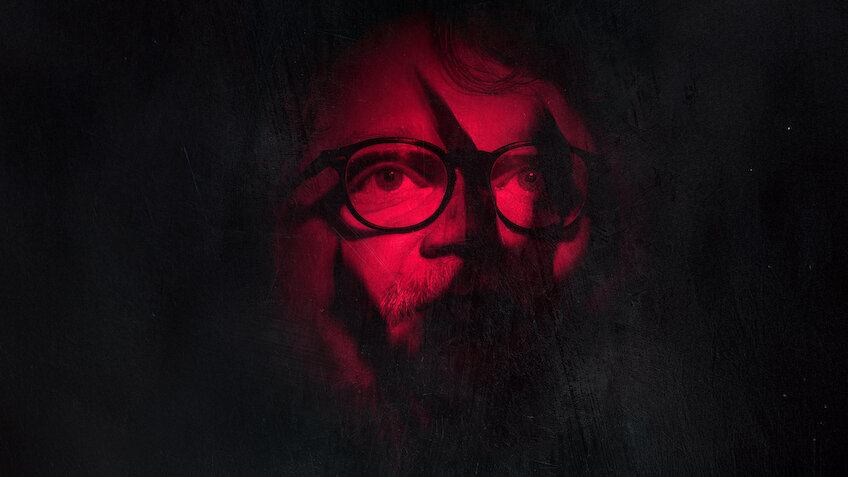Guillermo del Toro, the filmmaker who taught us that beauty can have gills and that innocence often requires disobedience to survive, has always inhabited an uncomfortable space: the intersection of aesthetic horror and radical tenderness. His narrative universe serves as a continuous argument in favor of the flawed, the marginalized, and the gloriously incorrect. For many, Del Toro does not merely tell stories; he charts an emotional map that justifies the existence of what society strives to hide.
The Banquet of the Imperfect Monster
This deeply personal vision is the central axis of Sangre del Toro, a documentary presenting itself as the most intimate X-ray of his creative psyche. It is less a formal biography and more an immersion into the mental architecture that breathes life into his creatures. Directed by French filmmaker Yves Montmayeur—a documentarian with vast experience exploring the world of cinema who presented this work in the Venice Classics section—the film deliberately moves away from a chronological timeline. Montmayeur, with a two-decade career, seeks to offer an “intimate journey” into the creative universe, portraying Del Toro simply “at a moment in his life.”
The documentary focuses on unraveling the mental architecture of the director from Guadalajara. It is not a classic biography; instead, it dives straight into the director’s mind, gathering testimonies from Del Toro himself and close collaborators, such as art director Eugenio Caballero. Visually, the film employs a brilliant resource: it utilizes extensive footage from the massive At Home with My Monsters (En casa con mis monstruos) exhibition, presented in Guadalajara in 2019. The exhibition itself is an object of study, focusing on the art of what is considered monstrous, not just in physical form but also in “behavior or meaning.”
By blending this vast personal archive with scenes from his major productions—such as Hellboy, Pan’s Labyrinth, and The Shape of Water—the documentary uses the collection as if it were the biography itself. The exhibition, being a synthesis curated by Del Toro of all his influences (from Mexican sacred art to references to Edgar Allan Poe), allows the documentary to map the director’s psychological development without needing to follow a linear calendar. The film’s structure, therefore, mimics the associative and non-linear nature of Del Toro’s own imagination.
“We Must Be Broken”: The Philosophy of Art Without Pedigree
If there is a philosophical point that defines the essence of the Mexican director, and which the documentary captures crucially, it is his defense of incorrectness. Del Toro surprised audiences in Venice with a statement that becomes the central thesis of his art: imperfection is not a deficiency, but the necessary source of creation. Capturing the director’s voice in a moment of great conviction, the documentary emphasizes his assertion that imperfection is desirable.
Del Toro formulated it bluntly and with a dose of dark humor: “We can be broken and create art. In fact, we must be broken!” This idea goes beyond mere permission to err; it is a profound reflection on authenticity. True art, he suggests, must be born from discomfort and friction. This philosophy of the flaw is presented as a vigorous rejection of the demands for purity or perfection imposed by rigid structures.
The rhetorical question Del Toro launches reveals the social intention of his work: “We don’t have a position in the church, we aren’t politicians, so why should we be perfect?” By shedding the need for a moral or institutional pedigree, the artist frees himself to portray human truth in its “rawest features.” The acceptance of these flaws and this intrinsic “brokenness” connects directly to one of the great narrative engines of his filmography: disobedience.
If the established order demands an unreachable perfection (dogma, power), then the act of embracing one’s imperfect reality becomes the most moral and human act. It is disobedience that guides Ophelia in Pan’s Labyrinth to seek the truth, and it is the acceptance of mortality and imperfection that allows his Pinocchio to achieve humanity. The documentary, by tracing these parallels, demonstrates that Del Toro’s work is a sustained argument against the whitewashing of social and emotional reality, using the monster as a tool for dignification.
The Labyrinths of Guadalajara: Mexican Blood in Global Horror
To understand where this appetite for the gothic and the imperfect originates, Sangre del Toro necessarily travels to Guadalajara. The documentary delves into the director’s formative childhood, a period marked by an infantile fear of death. Del Toro shares in the film how his parents would leave him at the cinema from ten in the morning to watch horror movies, a ritual that planted his early and deep love for the genre.
This early and practical relationship with cinema was established at a surprisingly young age. Del Toro recounts making his first film at eight years old, using his father’s Super 8 camera. This detail underscores that his identity as a filmmaker was not a late vocation, but an expressive necessity manifested almost from the cradle. The film traces not only the origin of his technique but also his aesthetics. The anchor points of his gothic style are revealed as deeply local. His taste for the gothic, he confesses, comes from the imposing Guadalajara Cathedral. Furthermore, Mexican culture, with its familiarity and cult of death, is identified as an element “very deeply embedded in Del Toro’s spirit.”
This connection contrasts with the common narrative that views horror cinema as purely Eurocentric, demonstrating that Del Toro filtered the genre through the prism of fatality and Latin baroque melodrama, elevating Mexican iconography to a level of influence as vital as classic monsters. A constant narrative element in his stories is his love for labyrinths, a fascination the director also addresses in the documentary. The labyrinth is, by definition, a structure of search and confusion that encapsulates fear and the need to find a path through perceived chaos. By connecting these narrative structures with his native geography, the documentary highlights that Del Toro’s “blood” is an indivisible amalgam of global horror and Guadalajara tradition.
Bleak House: The Collection as Externalized Conscience
If Del Toro’s childhood explains the origin of his fascination, his personal collection in Los Angeles, known as “Bleak House” (a nod to Charles Dickens), is the tangible materialization of that mind. The documentary uses this residence—an unusual museum filled with over 600 objects reflecting his obsession—to explore his perennial fascination with the monstrous.
The celebrated At Home with My Monsters exhibition, whose images are a visual pillar of the documentary, is essentially the public export of his creative consciousness. The collection is intentionally eclectic, as its purpose is to examine the art of the monstrous not only in its physical form but also in its “behavior or meaning.” The show reveals Del Toro’s methodology: how he takes vast and foreign influences (from Poe and Lovecraft to Moebius) and transforms them, placing them in context with the Mexican fantastic imagination. This includes comparing foreign mythologies with sacred art and Mexican political caricature, which have historical roots dating back to the colonial era.
This dedication to his objects goes far beyond simple collecting. When part of his collection was packed for the exhibition at the Los Angeles County Museum of Art (LACMA), the director admitted feeling deeply uncomfortable and declared that the house felt “empty.” He considers these creatures and artifacts his “companions” and “caretakers.” This detail reveals a deeply human and vulnerable aspect of the director. Bleak House is not just an art warehouse, but a psychological sanctuary. By showing this emotional dependence on his “monsters,” the documentary illustrates how collecting becomes a defense mechanism against the chaos of the outside world. He is an artist who needs to build a physical refuge for his imagination, and the film documents the intimate relationship between the man and his creatures.
Anatomy of the Antagonist: True Horror Wears a Suit and Tie
The exploration of Del Toro’s mind in Sangre del Toro reveals that his fascination with monsters has always been an oblique form of social criticism. A fundamental premise of his cinema is that power structures and systemic oppression are the true antagonists, not fantasy creatures. His films, such as Pan’s Labyrinth, use fantasy as a “refuge and act of resistance” against the “oppression and violence of the adult world.”
The director identifies the source of the modern monster as ideological. Brutality does not emanate from biology or the supernatural, but from “certainty, dogma, and following the idea that it is ‘us vs. them’.” Division is, for Del Toro, the root of inhumanity, and his cinema seeks to expose authority that disguises cruelty. In fact, he states that the most brutal monsters of today wear “suits and ties.”
This philosophy acquires vital contemporary relevance when Del Toro applies it to immediate social problems. In the documentary, he is heard reflecting on the state of migration, lamenting how “absolutely terrible” it is to view migration as a harmful factor. He considers this stance insanity, given that a country like the United States was “created based on migration.” By linking the archetype of the monster—a marginalized and rejected being (like Frankenstein’s monster)—with the experience of the modern migrant, Del Toro transforms classic horror tropes into an immediate political parable about alienation and the cruelty of borders. The documentary confirms that under the veneer of dark fantasy lies an author with a deep humanistic commitment who seeks empathy even in the most deformed characters.
A Final Performance: The End of a Cycle and the Next Transformation
Sangre del Toro does not only look back; it documents a professional turning point. The documentary captures the atmosphere of collaboration and generosity that defines his creative process. Del Toro, known for his ability to inspire his teams, described one of his lead actors as someone who would make “a banquet” of the role, confirming his commitment to an environment that fosters expressiveness and high creative performance.
However, the director’s most revealing testimony is his own self-evaluation. Del Toro categorically confirms that his latest film project represents the end of an era: “I knew it is the end of a cycle; I am very clear on that.” According to him, everything he practiced and produced during three decades of directing culminated in that film, marking a point of closure before a “new cycle” begins.
This declaration confers a particular historical weight to Sangre del Toro. Directed by Montmayeur, the documentary becomes not only a case study on creativity but the definitive retrospective on the philosophy, influences, and methodology that defined the Guillermo del Toro of the first stage: the man behind Pan’s Labyrinth, The Shape of Water, and the animated Pinocchio. By documenting the creative consciousness just as the artist declares the closing of his dominant aesthetic phase, the film serves as the essential chronicle of the “blood” that fueled these three decades of fantasy. Montmayeur’s work is, therefore, a culmination and a farewell, a detailed map of the road traveled before the next artistic metamorphosis.
The Date on Netflix
Prepare to enter the tenderest and most terrifying mind in contemporary cinema, as the intimate journey into Sangre del Toro premieres on Netflix on November 21.






